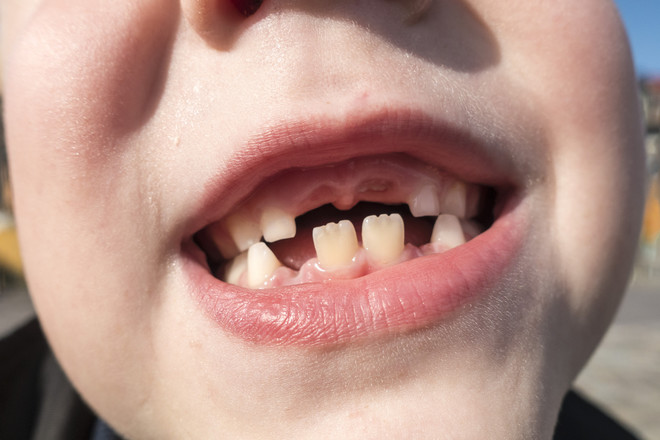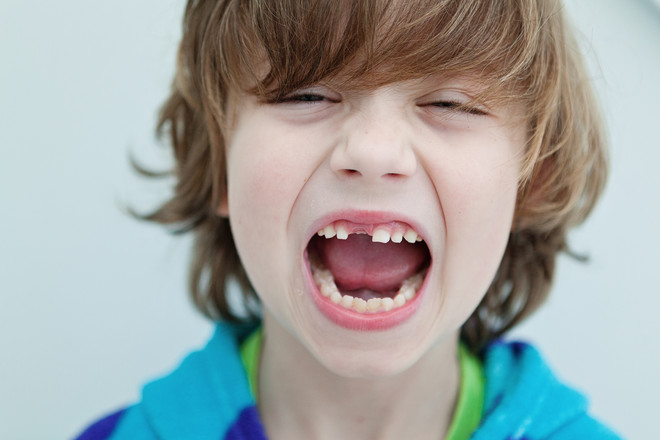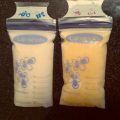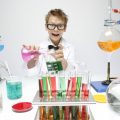How can milk teeth change?
Formally, baby teeth also have roots, theyare practically no different from permanent teeth. However, when the time comes for the change, the roots of baby teeth simply dissolve, allowing permanent teeth to grow. There is another difference: there are only 20 baby teeth, while 32 "adult" teeth must form. A child's permanent teeth can be baby teeth orpermanentPhoto: GettyBaby teeth are formed in the mother's womb and begin to grow after birth. The first temporary molars - molars - can appear as early as 6 months. The growth of baby teeth should end by the age of 3. At 3 years, permanent teeth begin to form in the gum, and baby teeth gradually become loose. The replacement of baby teeth with permanent ones begins at about 5 years of age and ends by the age of 14. A wisdom tooth can present surprises. Its appearance can be significantly delayed.
A child's permanent teeth can be baby teeth orpermanentPhoto: GettyBaby teeth are formed in the mother's womb and begin to grow after birth. The first temporary molars - molars - can appear as early as 6 months. The growth of baby teeth should end by the age of 3. At 3 years, permanent teeth begin to form in the gum, and baby teeth gradually become loose. The replacement of baby teeth with permanent ones begins at about 5 years of age and ends by the age of 14. A wisdom tooth can present surprises. Its appearance can be significantly delayed.
At what age do permanent teeth appear?
Permanent teeth grow under the baby teeth.Their appearance is individual. In some children, they can start to "come out" at 5-6 years old, while in others, you have to wait until they are 7 years old. This is also not a pathology, most likely, the teeth are simply not ready to appear yet. The first molars do not push out the baby teeth. They stand in the place where there were no teeth yet. Teeth grow in pairs. Behind the first molars, 2 incisors appear, later - 2 more. After the incisors, premolars appear, the teeth located in front of the molars. They will be followed by the 2nd pair of premolars. Next, the canines cut through, and after them the 2nd pair of molars. The growth of teeth ends with the appearance of the 3rd pair of molars - wisdom teeth. They come out last of all and occupy the empty spaces at the end of the jaw. These teeth can appear at the age of 21. Milk teeth are gradually replaced bypermanentPhoto: GettyThese teeth appear first on the lower jaw, then on the upper jaw. You can see the appearance of each tooth, the interval is given for the teeth of both jaws:
Milk teeth are gradually replaced bypermanentPhoto: GettyThese teeth appear first on the lower jaw, then on the upper jaw. You can see the appearance of each tooth, the interval is given for the teeth of both jaws:
- 6-8 years - 1 molar;
- 6-8 years - central incisor;
- 7-9 years - lateral incisor;
- 9-12 years - fang;
- 10-12 years - 1 premolar;
- 10-12 years - 2 premolars;
- 11-13 - 2 molars;
- 17-21 - 3 molars.
The duration of tooth replacement depends on the child’s health.
The main symptoms of teething
The appearance of baby teeth is quite painful. He starts whining for no apparent reason, and his temperature may rise. The signs of teething are as follows:
- The kid is naughty and stops eating.
- The gums are swollen, white whorls can be seen on them.
- The saliva is plentiful.
- The temperature rises.
- An upset stomach may occur.
The mother should follow the pediatrician's recommendations,to relieve pain. Permanent teeth may appear painlessly and unnoticed in some, while others suffer from unpleasant symptoms. There may be a high temperature and salivation. At this time, the child's immunity may decrease and a runny nose may appear. Inflammation of the gums can be reduced with dental gels, applied with a disinfected finger. Gum massage will help a little. If the high temperature lasts for several days, you should see a doctor. If permanent teeth grow in a second row behind baby teeth, you should visit a dentist. In order not to spoil the bite, baby teeth should be removed. Removing them is not difficult, since nothing is left of the roots by the time the permanent teeth appear. Teeth with roots appear in babies from 6 months. But their roots disappear when the permanent ones are ready to form. The intervals for changing teeth are standard, but there may be deviations that depend on the baby's health.









